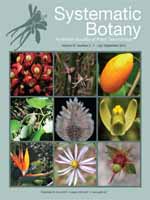The systematics of subtribe Symphyotrichinae were studied with sequence data from two nuclear regions: the 18S–26S nrDNA internal and external transcribed spacers (ITS and ETS) and the 5S nrDNA non-transcribed spacer. The primary objective was to use data from these two regions to resolve relationships among Almutaster, Psilactis, and Symphyotrichum. The combined ITS ETS data and the 5S data were subjected to phylogenetic analyses using parsimony and Bayesian methods. Both datasets identified two major clades in Symphyotrichinae: one consisting of Almutaster, Psilactis, and Symphyotrichum subgenus Virgulus, and the other consisting of most other species of Symphyotrichum, including all species of S. subgenus Symphyotrichum. In addition, there were seven instances of disagreement between the ITS ETS and 5S results. Assessments of these incongruences suggested that there have been three occurrences of reticulate evolution, involving six species of Symphyotrichum: 1) S. tenuifolium, 2) S. moranense S. trilineatum, and 3) S. concolor S. ericoides S. pratense.
How to translate text using browser tools
1 September 2012
Systematics of Symphyotrichinae (Asteraceae: Astereae): Disagreements between Two Nuclear Regions Suggest a Complex Evolutionary History
David R. Morgan,
Blake Holland
ACCESS THE FULL ARTICLE

Systematic Botany
Vol. 37 • No. 3
July 2012
Vol. 37 • No. 3
July 2012
5S rDNA non-transcribed spacer
introgression
nuclear incongruence
Psilactis
reticulate evolution
Symphyotrichum




